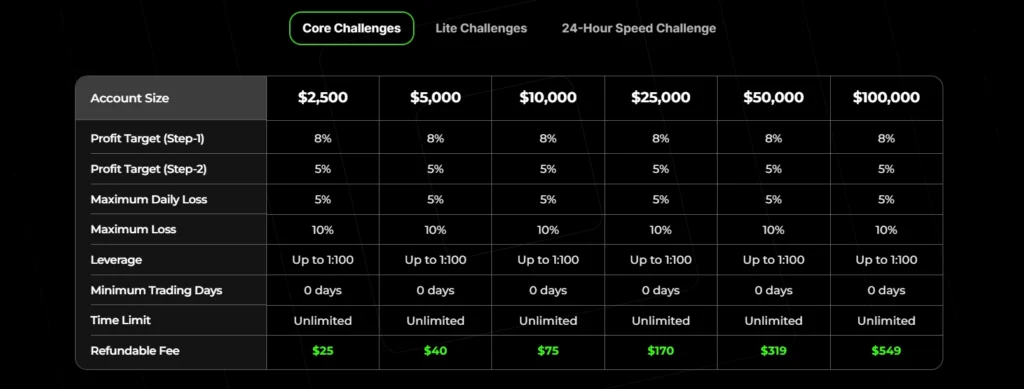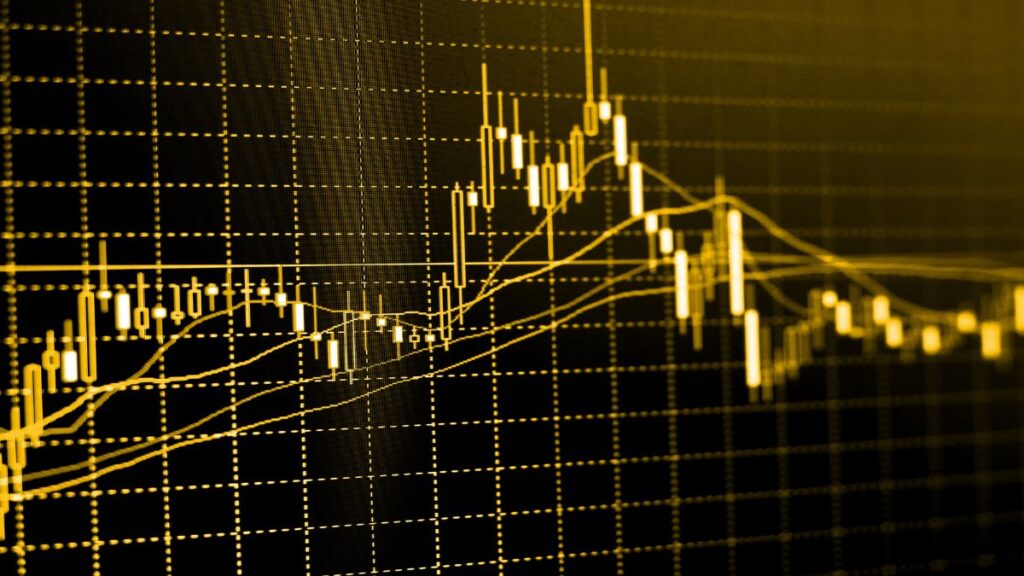The best 2025 gold strategy combines a trend filter, volatility-based position sizing, and precise trading sessions, supported by record demand data and clear rules for entries and exits.
Gold trading has surged again in 2025 as investors seek safety and opportunity. Global gold ETFs added US$38 billion in inflows in the first half of 2025, pushing holdings to 3,639 tonnes and assets under management to US$386 billion (World Gold Council, 2025). This shows traders are not only watching charts but also relying on macro flows. A structured strategy is essential to trade profitably without being caught off guard by volatility.
For traders who want to scale their approach, gold is available within MasterFunders challenges, alongside forex, indices, and crypto.
What Is The Best Gold Trading Strategy Right Now?
In 2025, the most reliable strategy is trend-plus-pullback: trade long above the 50-day moving average, enter on RSI recovery from oversold, size positions by ATR, and focus on London–New York overlap hours.
Gold is in a strong uptrend, setting repeated all-time highs in 2025 as central banks buy aggressively and inflation worries drive demand. A simple structure works:
- Trend filter: only trade long when gold holds above the 50-day moving average.
- Pullback entry: use RSI (14) to time entries when it rises from below 40 during an uptrend.
- Risk sizing: adjust by volatility, cutting size by half if the 10-day ATR exceeds $30.
- Session timing: execute mainly during the London–New York overlap, when spreads are tightest and price discovery is strongest.
This method filters out low-quality trades and ensures positions are taken only when flows, momentum, and liquidity align.
What Are Effective Strategies For Spot Gold Trading?
The three most effective spot gold strategies in 2025 are range trading, continuation breakouts, and news-driven setups, each matching a different trader profile and risk tolerance.
Range trading works best in sideways periods. Identify support at prior lows and resistance at prior highs, then buy at the bottom and sell near the top.
Continuation breakouts fit trending conditions. For example, a close above the previous day’s high during the New York session often signals strong momentum.
News-driven setups capitalize on macro events like U.S. CPI releases, Federal Reserve announcements, or unexpected geopolitical developments. These moves can be sharp, so traders should use small size and wider stops.
Whichever method is chosen, risk limits matter more than predictions. A stop-loss below support or the last swing low helps prevent a losing trade from spiraling.
Compare styles like day, swing, and position trading in Day Trading vs Swing Trading vs Position Trading.

What Is The Best Intraday Gold Trading Strategy?
The best intraday gold strategy in 2025 is a 30-minute breakout aligned with the daily trend, confirmed by a volume spike in the first 90 minutes of the New York session.
Intraday traders benefit from clear structure:
- Levels: mark yesterday’s high and low as breakout points.
- Trigger: wait for a 30-minute candle close above resistance with a body at least 0.3–0.5% of gold’s price.
- Volume confirmation: ensure volume is 50% higher than the prior three bars.
- Stops and targets: place stops below the last swing low, aim for a 2:1 reward-to-risk ratio, and trail the remainder.
- Exit rule: close trades by session end to avoid overnight gaps.
This approach avoids random intraday noise and focuses on liquidity peaks. The London–New York overlap is the most liquid and reliable session for such setups.
If you want to understand how intraday fits into trading psychology and career paths, see Day Trade for a Living $1000.
What Are The Best Times To Trade Gold?
The best times to trade gold are during the London–New York overlap, especially the first 90 minutes after New York opens, when liquidity and volatility are highest.
Liquidity in gold is not evenly distributed. The overlap between 8:00 a.m. and 12:00 p.m. EST sees the most price discovery as both European and U.S. traders are active. During this period, spreads tighten, volume spikes, and technical signals become more reliable (Investopedia, 2025).
Secondary opportunities occur during the London open (3:00–5:00 a.m. EST), while the Asian session is usually quieter unless major geopolitical headlines break.
By focusing on high-volume sessions, traders can reduce slippage and improve execution. This timing edge becomes even more valuable when combined with breakout or pullback strategies.
For insights into market volatility and timing, see Dow Jones All Time High and S&P500 All Time High.
Which Indicators Work Best For Gold?
The most effective indicators for gold in 2025 are the 50-day moving average, 21-day exponential moving average, RSI (14), and ATR (10), supported by real yields over the U.S. Dollar Index.
Trend filters: The 50-day simple moving average (SMA) defines overall bias, while the 21-day EMA helps time pullbacks.
Momentum: The Relative Strength Index (RSI) spots exhaustion, with entries often triggered when RSI turns up from 35–40 in an uptrend.
Volatility: The Average True Range (ATR) sets stop distances and adjusts position size.
Macro overlay: While traders often track the U.S. Dollar Index, gold’s strongest relationship is with real yields rather than nominal dollar moves (Science Direct, 2025).
| Indicator | Typical Setting | Role in Strategy |
| 50-day SMA | 50 periods | Bias filter |
| 21-day EMA | 21 periods | Pullback entries |
| RSI | 14 periods, 30–70 levels | Overbought/oversold timing |
| ATR | 10 periods | Volatility sizing |
To see how these tools fit within broader prop trading guidelines, review Prop Firm Rules.
How Should I Size Positions In Volatile 2025 Markets?
Position sizing in 2025 gold trading should follow a volatility-based model, halving size when the 10-day ATR exceeds $30 and cutting further when it rises above $40.
Gold’s trading ranges expanded sharply in 2025. When volatility rises, traders risk overexposure if they keep position size constant. A volatility-adjusted plan keeps risk in check:
- ATR ≤ $30: trade full size (1R risk).
- ATR $30–40: reduce to half size (0.5R).
- ATR > $40: cut further to one-third size (0.33R).
This method ensures consistency regardless of market swings. It also allows traders to survive extreme sessions without blowing through account limits (Investopedia, 2025).
For more on account safety and rules that mirror these adjustments, see Risk Management Rules Prop Trading.
What Macro Drivers Move Gold In 2025?
The dominant macro drivers for gold in 2025 are central bank demand, ETF inflows, and real yields, each reinforcing gold’s safe-haven appeal.
- Central banks: Purchases reached 1,045 tonnes in 2024, marking the third consecutive year above 1,000 t and signaling continued strategic accumulation (WGC Demand Trends 2024).
- ETF inflows: Global gold ETFs added US$38 billion in H1 2025, with holdings climbing to 3,639 tonnes and assets under management reaching US$386 billion.
- Real yields over dollar: Gold’s sensitivity lies more in real U.S. yields than the U.S. Dollar Index, especially during unsettled markets (CME Through the Lens of Gold).
Key risks to monitor include U.S. CPI, Federal Reserve policy actions, and geopolitical shocks notably in Europe and the Middle East.
Which Indicators Work Best For Gold?
In 2025, the most effective indicators for gold trading include the 50-day SMA, 21-day EMA, RSI (14), ATR (10), and real yields rather than the U.S. Dollar Index.
- Trend bias: The 50-day SMA defines the main trend; go long when price is above it.
- Pullback timing: Use the 21-day EMA for spotting optimal re-entry points in trending markets.
- Momentum trigger: The RSI (14) helps identify rebound entries when it turns up from the 35–40 zone during an uptrend.
- Volatility sizing: The ATR (10) sets adaptive position sizing and stop distances.
- Macro alignment: Real yields better explain gold’s price action than the U.S. Dollar Index, particularly in uncertain markets (CME Through the Lens of Gold).
| Indicator | Typical Setting | Role in Strategy |
| 50-day SMA | 50 periods | Bias filter |
| 21-day EMA | 21 periods | Pullback entries |
| RSI | 14 periods | Overbought/oversold timing |
| ATR | 10 periods | Volatility-based sizing |
Trade Gold With Bigger Capital Through MasterFunders
To trade gold successfully in 2025, you need a clear strategy, risk control, and the right trading conditions. If you want to scale your profits without risking your own capital, MasterFunders offers the ideal path.
With MasterFunders, you can trade gold and other instruments on funded accounts up to $200,000, keeping up to 90% of profits while following clear, trader-friendly rules.
Key Benefits of Trading Gold With MasterFunders
- Funded accounts up to $200,000 after passing the evaluation.
- High profit split: up to 90% of profits, above industry averages.
- No minimum trading days: trade at your pace with full flexibility.
- Second Life & Reset features: restart after setbacks without losing everything.
- Biweekly or on-demand payouts: faster access to profits than most firms.
- Trade a wide range of assets: including gold, forex, indices, stocks, and crypto.
- Education and support: access learning resources and join a growing trading community.
If you’re ready to put your gold strategy into action, start with a MasterFunders Challenge. Prove your skills, scale your account, and trade gold with the backing of real funding.

FAQs About Gold Trading Strategies
What Is The Simplest Gold Trading Strategy In 2025?
Range trading is the simplest: buy near support levels, sell at resistance. It works best when gold is consolidating and avoids complex indicators. Stops should sit just beyond the range boundaries.
What Time Is Best To Trade XAUUSD?
The most liquid time is the London–New York overlap (8:00 a.m.–12:00 p.m. EST). The first 90 minutes after New York opens often deliver the strongest moves.
Which Indicator Is Most Reliable For Gold Trading?
The 50-day moving average provides the clearest trend filter. When price holds above it, traders favor long positions. Combining it with RSI pullbacks improves entry timing.
How Do Real Yields Affect Gold Prices?
Falling real yields generally push gold higher as they reduce the opportunity cost of holding the metal. This driver is stronger than the traditional gold–U.S. Dollar Index link.
How Should I Size Positions In Volatile Gold Markets?
Use ATR-based sizing. Trade full risk when ATR ≤ $30, half-size when ATR is $30–40, and one-third size when ATR > $40.
Can Beginners Trade Gold Profitably?
Yes, but beginners should start with demos, apply strict risk management, and keep risk per trade at 1–2%. Testing strategies before live trading reduces costly mistakes.


